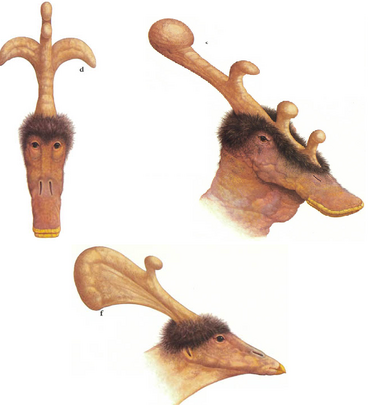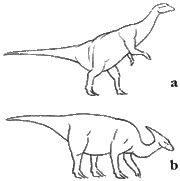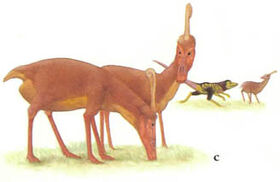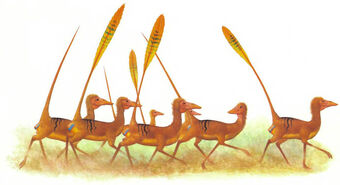
Crests vary from species to species of crested sprintosaur and are used as signaling and identification devices. The shapes range from hook shapes, as in Ancorachephalus major, (d), through rows of knobs, as in Sprintosaurus quadribullus, (e), to broad blade shapes, as in S. dolabratops, (f).
The sprintosaurs (Family: Sprintosauridae) are a unique group of strictly quadrupedal hadrosauroids found in the prairies and grasslands of North America, descended from North American hadrosaurs, in The New Dinosaurs: An Alternative Evolution.
The prairies - the Great Plains grasslands that spread out across the center of the North American continent from the great winding Mississippi River on the lowland plain to the towering wall of the massive western Rocky Mountains - support vast herds of grazing animals. The most widespread of these are the sprintosaurs, evolved from the North American varieties of duck-billed hadrosaurs of the Late Cretaceous. In the last 65 million years, as the forests gradually gave way to the grasslands, the Nearctic hadrosaurs evolved to adapt to the changing habitats. Like the particular hadrosaurs before them, there are two main groups of sprintosaur, the crested, and the non-crested.

The sprintosaurs evolved from the North American types of hadrosaurs of the Cretaceous period. These, in turn, evolved from completely bipedal ornithopod dinosaurs (a) but began to spend more time on all four legs (b).

When they evolved into the plains-living sprintosaurs, the North American hadrosaurs became completely quadrupedal (c). The legs are long and lightweight, with muscles concentrated in the thighs and upper arms, and the tail, having lost its balancing function, has degenerated either to a stump or to a flagpole.
The crested sprintosaurs tend to inhabit the western High Plains, grazing the short grasses and undergrowth of prickly pear cactuses in the dry shadow of the Rocky Mountains. In the long evenings of the mating season the thin upland air resonates to the shrill trumpeting sounds as the crested sprintosaurs call to one another, using the hollow crests as sounding tubes. The crests are formed from the bones of the nose. They probably evolved to extend the nasal passage and allow dry air to pass over moist membranes before reaching the lungs. They successfully perform this function, because the air of the high prairie is very dry. Distinctively shaped crests are found in different species of crested sprintosaur and serve to distinguish members of one species from another, as they roam the sparse grasslands below the mountain ramparts. Both male and female crested sprintosaurs possess the crest.
The non-crested sprintosaurs, like their slightly larger crested cousins, also evolved from the hadrosaurs of North America. However, while the crested forms evolved from such lambeosaurine hadrosaurs as Corythosaurus and Parasaurolophus, the non-crested forms evolved from the saurolophine hadrosaur line that included Hadrosaurus and Edmontosaurus. Since Cretaceous times, their evolution into a grassland animal was parallel to that of the crested sprintosaurs. The cropping beak and the huge battery of constantly replaced grinding teeth needed little modification to suit a diet of tough, silica-rich grasses. As their faces were permanently in the grass, eating, the animal adopted a strictly four-footed posture. On the open plains danger can be seen from a long way off and so the legs became spindly and lightweight to enable the animal to run swiftly from harm. The face became long to keep the eyes above the level of the grass so that a lookout could be kept for predators while grazing.
The main difference between the non-crested and crested sprintosaurs, apart from the crest, is the length and appearance of the tail. Having lost its function as a counterbalance, necessary when its ancestors partly went about on two legs, the tail has become a tall, stiff flag post. The males have a fin of skin supported by bony struts at the tip, and this is used for signaling. Different species have different sizes and patterns of fin. The non-crested sprintosaurs live mainly on the long grass, in lowland prairies where the adaptations of the particularly long face and the tail flag are of most use. The sprintosaurs, both crested and non-crested types, travel over the plains in closely-knit herds.

Vexillosaurus levipes is a non-crested sprintosaur from the Mississippi Embayment floodplains of the Mississippi River. It moves about in tight herds often only seen as a bunch of tails waving above the long grasses. When a predator such as a northclaw attacks, the herd breaks up in a confusing flurry of flags and poles, leaving the attacker bewildered.
